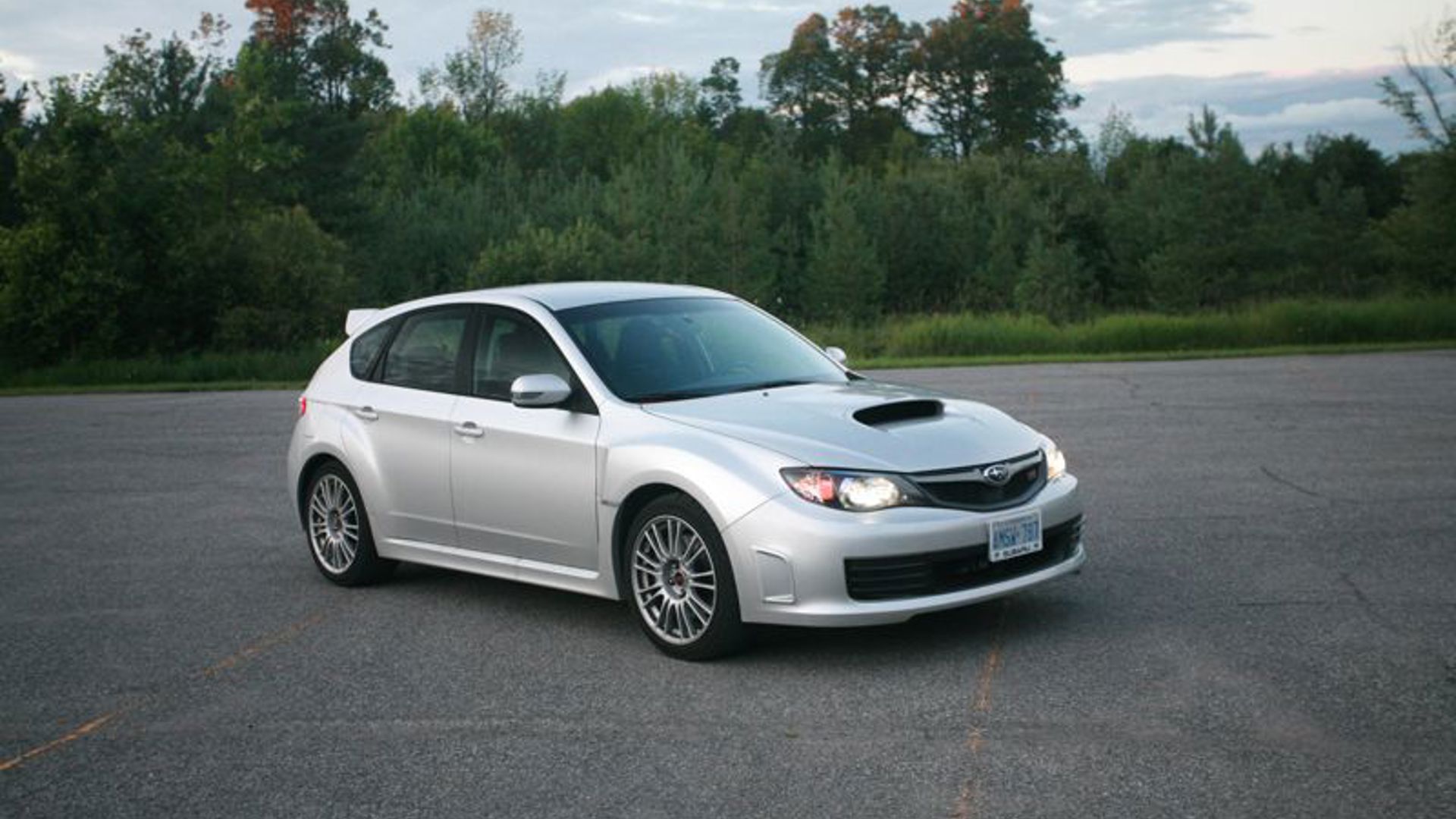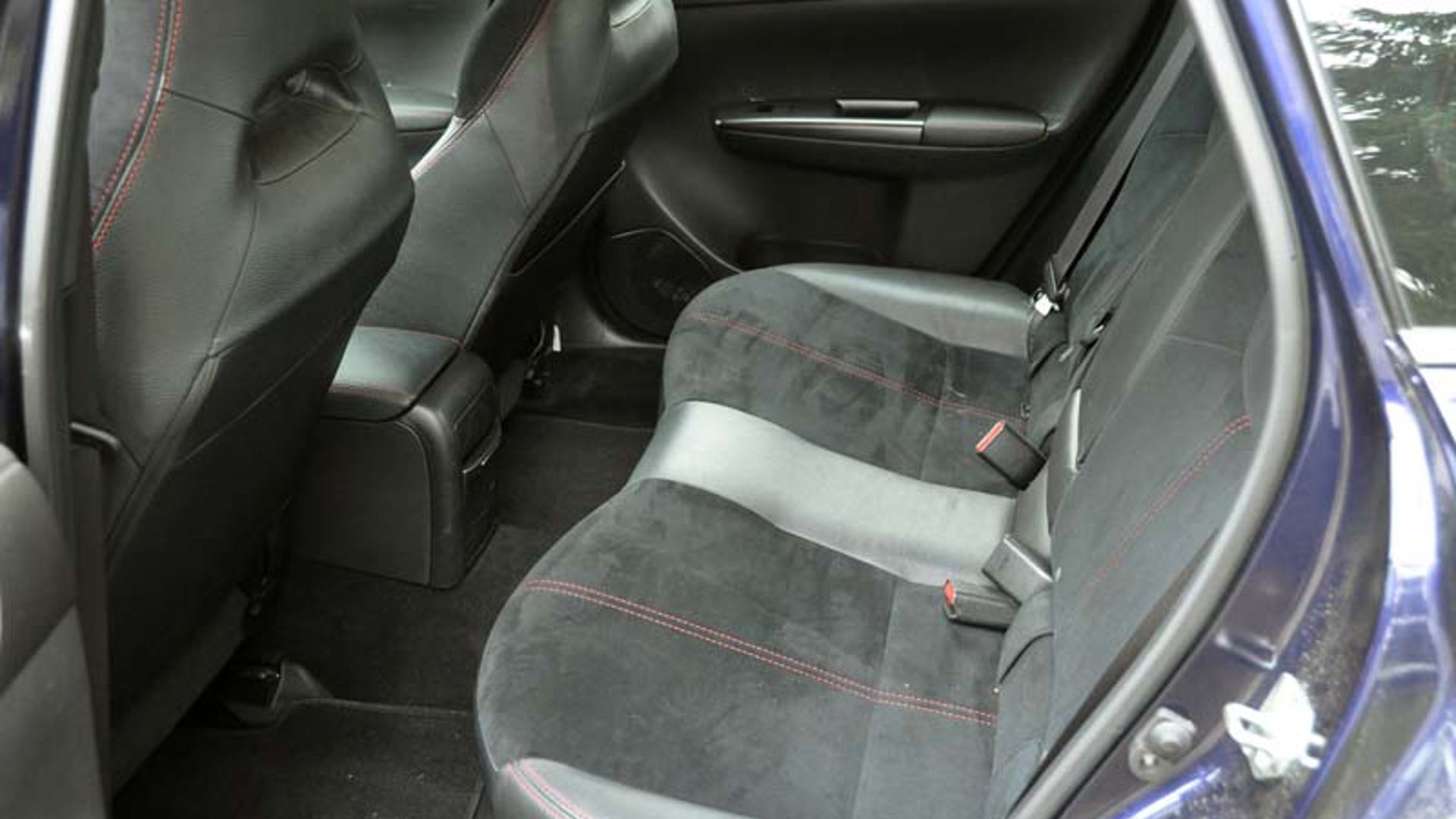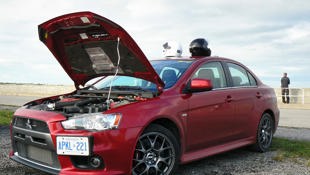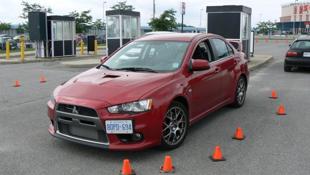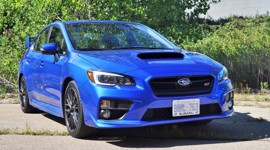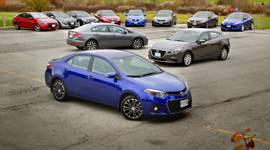Winter is a nasty season. It’s frigid, depressing, grey and awful, and it prompts countless Canadians to pack up, head somewhere nice, and avoid our climate until springtime re-arrives.
These machines are the real deal.
Driving in winter can be depressing, too – unless you’re properly equipped. There’s a solution to the winter motoring blahs, and that solution involves travelling by street-legal rally car.
Not a real rally car, of course. Those are impractical and you’ll probably get arrested. But two popular Japanese models come fairly close in their factory setups. Those models are the Subaru WRX STI, and the Mitsubishi Lancer Evolution, aka, the Evo.
Similarities abound: both are turbocharged; both pack all-wheel-drive systems with fancy tech and highly customizable operation; both can be had with three pedals. The Evo and STI are similar in many ways, different in many others, and largely held as rival rocket sedans, supported by large communities of owners.
Which one is best? That all depends on your personal tastes, desires, driving style, and preferences. To your writer, the STI is a more challenging machine to drive hard in a motorsports setting, but a more rewarding one, once you form a relationship with it. The Evo, conversely, puts more of its talents and capabilities at the driver’s disposal from the get-go. It’s a little more forgiving.
Driving an STI is like playing your favourite racing game in Simulator mode, where the Evo is more like playing it on Arcade mode. Similar hardware, unique tuning, and plenty of everyday-friendly performance are on offer from both. I know over a dozen performance driving instructors and retired race car drivers who use an STI or EVO as their everyday car. Translation? These machines are the real deal.
Maybe, you’re after a used one. And, if that’s the case, you’ve come to the right place.
Listen closely. Hear that? It’s the sound of a high-output turbo engine driving all four wheels while you powerslide through conditions that leave lesser rides quivering in soggy fear.
Below, we’ll look at some tricks and advice, as well as a few pro tips, to help you shop smart for a first-class, second-hand copy of the last-generation Evo or STI.
Subaru WRX STI, 2008–2014
The Draw
Subaru knows a thing or two about getting Canadians around in nasty weather, and their popular WRX STI is powerful proof. Launched for model year 2008, the STI variant of the last Impreza WRX carried on through 2014 in this generation.
In any case, the WRX STI is a sort of factory-equipped rally car you can drive to work, to the grocery store, to the slopes, and to the Canadian Tire parking lot for a late-evening donut sesh after a blizzard. Owners like the utility, real-world drivability, and built-in connection with a strong owner’s community. Look for a manual transmission, AWD, and a 2.5-litre Boxer turbo engine making around 300 horsepower in all models.
In this comparison, the STI pulls ahead with better real-world ride quality, a more refined driveline, and a higher-quality feel to the interior. Plus, unlike the Evo, this model was available in a five-door hatchback, with more room and utility. It could almost pass as a little family hauler.
The Test Drive
If you’re an enthusiast after a new-to-you STI, you likely know at least a friend or two who own one. Bring one along for the test drive for a second opinion. Ask the seller to ensure the unit you’ll be test driving isn’t pre-warmed ahead of your arrival, since you’ll want to watch the tailpipes for smoke as the engine heats up to operating temperature, but before you drive it. White, oily smoke could indicate a bad turbocharger, and sellers may pre-warm the unit to conceal other issues too.
For protection against a well-documented piston ringland failure issue, be sure the model is stock in its engine tuning, and have a Subaru mechanic do a compression test to ensure all cylinders are healthy and gas-tight. A compression test can also reveal a potential problem with engine head gaskets.
A pre-purchase mechanical inspection can go a long way to reveal potential problems with leaky differentials, excessive rust and the condition of the suspension system. Be sure to ask your favourite technician to look for signs of a bad serpentine belt pulley, too. Confirm proper operation of the automatic climate control, wiper de-icer system and seat heaters.
Two things are vitally important to successful used WRX STI shopping.
First, ensure the unit has been religiously dealer-maintained, using only quality parts, proper fluids, and strict adherence to the factory maintenance schedule. In all cars, and especially high-performance ones, proper and timely maintenance goes a long way towards prolonged durability and reliability.
Second? Again – be sure the unit is as close to stock as possible. Exhaust and intake upgrades, as well as quality wheel upgrades, are typically fine – though the average shopper should likely avoid a model with non-factory turbocharger system components or tuning, and modified suspension parts. Stock is best for maximum durability, peace of mind, and confidence.
Mitsubishi Lancer Evolution, 2008–2015
The Draw
Mitsubishi’s WRX STI fighter packed a two-litre four-cylinder engine with 291 horsepower, available Twin-Clutch Sportronic Shift Transmission (TC-SST), and a list of upscale features and systems. Award-winning Super All Wheel Control (S-AWC) technology ensures entertaining access to the full performance capabilities of the Evo on any surface, and drivers could select special modes for Snow, Gravel or Tarmac.
Bluetooth, navigation, racing seats, a driver computer, automatic climate control and xenon lights were all on offer. The Evolution MR was the top-line model with all the goodies, while the Evolution GSR is more affordable at the expense of some feature content.
In this comparison, the Evo stands out with racier looks, a more high-tech driveline and easier control over the AWD system, thanks to a three-mode toggle switch. If, for some reason, owning a manual transmission model isn’t a possibility for you, the EVO’s available TC-SST gearbox is your answer.
The Test Drive
Chances are, the used Evolution you’ll consider has been driven hard by its former owner(s). This in itself isn’t a problem – so long as all maintenance requirements are adhered to. Be sure the seller was fond of on-time changes of engine oil, coolant and transmission/differential fluid. A check of the brake and power steering fluid for level and condition is also advised.
Be absolutely sure the seller isn’t trying to stick you with the bill for a new clutch. Coax slippage from a worn clutch by applying full throttle at low rpm in a high gear, perhaps by flooring it at 50 km/h in fourth. Note that any grinding or “biting back” from the manual transmission during shifting is likely a sign of trouble, too. Some owners have reported premature clutch wear, though this may be a function of driving style.
If the unit you’re considering has the dual-clutch TC-SST transmission, be sure you can switch between all gears in order, that the unit responds quickly to accelerator inputs, and that no warning lights or messages are illuminated. Hard shifting or failure to engage specific gears are signs of potentially major problems.
A compression test is easy for a mechanic to complete on a four-cylinder engine like this one, and can provide some peace of mind that the engine in question is healthy, if you have any concerns. Be triple-certain to have a Mitsubishi technician look at your potential used Evo on a hoist to ensure that the Active Yaw Control (AYC) pump isn’t heavily corroded, too, as numerous owners have reported this potentially pricey issue. Many owners even apply a rust-proofing spray to this component for pre-emptive protection each fall. With the potential used Evo in the air on a hoist, a full check of the suspension is also recommended.
So, Which One is Best?
This is a question of the utmost trickiness, and a few things are worth bearing in mind before reading our recommendation.
First, two identical used cars can be in vastly different shape, and vary vastly in reliability, based on how they’ve been driven and cared for. Eliminate the guesswork by opting for a pre-purchase inspection at the vehicle’s dealer, to confirm that no major problems are lurking, and that the vehicle has been maintained correctly.
Second, the term “best” may vary. The Evo and STI both excel, and fall short, in certain areas, depending on one’s needs and tastes.
Third, take online owner reports with a grain of salt. In the enthusiast-populated online communities that surround both of these models, owners often self-select, vigorously trash the competition, and stir an echo-chamber effect in their posts. Further, remember that when it comes to reliability, nobody goes onto an owner forum to tell everyone how their vehicle performed flawlessly this week.
So, the answer? For us, it’s the Subaru WRX STI. Reason? In our opinion, it’s a more rewarding car to drive hard in a motorsports setting, has a higher-quality feel through its cabin, rides better on real-world roads, and packs the added flexibility of a five-door hatch, which can even make it an easier sell to that apprehensive significant other, if there’s a kid or two on the way.
Move on to our pro tip section below, for added useful information.
WRX STI and Lancer Evolution: Pre-Purchase Pro Tips
Keep the following general tips in mind for maximum confidence and peace of mind when considering a used STI or Evo.
Assume the Worst
Most sellers aren’t trying to stick you with the bill for a new clutch, brakes and tires, but some are. Approach any used WRX or Evo assuming it needs its tires, brakes and clutch replaced, until you, or a mechanic, confirm otherwise.
Chips/Tunes/Flashes
Whether it’s chipped, tuned, re-flashed or reprogrammed, modifications to an Evo or STI’s engine computer system are very common, and are best avoided by the average shopper. Non-factory software can increase performance and enjoyment, but it can also void any remaining warranty, or turn the vehicle’s engine into soup. Unless you’re experienced in the world of engine tuning, avoid a model that’s running non-factory engine software. Note that a large portion of reliability problems reported by owners online seem to be caused by non-factory engine parts, software, and non-factory add-ons.
All of the Fluids
Ensure all fluids are fresh in the model you’re considering, and not just the popular ones. Engine oil and coolant aside, your potential STI or Evo has power steering fluid, brake fluid, differential fluids and transmission fluids that can, and should, be kept fresh and clean for maximum long-term performance and durability. You can’t over-change fluids – so be sure to keep all of the fluids, even the less popular ones, full, fresh and changed frequently.
Turbo Check
Two ways to check on turbocharger health are worth noting. First, start the engine and let it idle up to operating temperature, before you drive it, perhaps for five or six minutes. In the process, take any white, oily smoke from the tailpipes as a sign that the turbocharger’s internal seals are failing. Second? Remove the turbocharger charge pipe plumbing provisions, and check for excessive oil buildup. A thin film of oil is typically considered acceptable, though pooling or dripping oil can be a trouble sign. Ask a mechanic for help if needed.
Computer Scan
Get the used Evo or STI hooked up to a code reader, for a scan of its engine computer. The cost is minimal (free, if you happen to own a code reader), and numerous potentially hidden issues can be revealed – whether or not there’s a check-engine light illuminated.
Contingency Fund
When shopping for either of these rides, be sure to leave some room in your budget for a few extra items. First, budget a few hundred bucks for a full fluid change and tune-up after you buy, in case the vehicle’s service records aren’t available. Second, budget for a set of winter tires if they’re not included, noting that even with advanced AWD and handling technology, use of the factory-spec tires in snow amounts to big-time danger. Third, remember that fluid changes, brake parts, tires, suspension components and the like are all fairly pricey to replace in cars like these. Count on spending about $220 on a pre-purchase inspection and compression test, as a final step before you agree to buy. And, finally, remember that insurance and fuel costs will be relatively high with these models, too.












